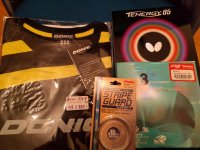@Nextlevel
For a stroke like mine, in order to come around the side of the balI, I will need to think about keeping the tip of the rubber facing the floor on the backswing, correct? With my current stroke, the tip of the rubber faces the wall behind me. It's hard for me to imagine coming around the side of the ball with my current backswing.
NL has been trying to get me to contact the ball more on the side on both wings for a long time. So I'm going to be a guinea pig and see how much this helps a player at my level.
For a stroke like mine, in order to come around the side of the balI, I will need to think about keeping the tip of the rubber facing the floor on the backswing, correct? With my current stroke, the tip of the rubber faces the wall behind me. It's hard for me to imagine coming around the side of the ball with my current backswing.
NL has been trying to get me to contact the ball more on the side on both wings for a long time. So I'm going to be a guinea pig and see how much this helps a player at my level.












